
A joke has structure. It has a central rule. Setup, punchline. The setup produces a tensed, expectant state; the punchline resolves the tension with a surprise. If the elements of the joke are not arranged into a setup and a punchline, it is not a joke. It is just a statement.
This is a matter of mechanical necessity; it’s true of every kind of joke, from long story jokes to one-liners. Consider this short, immaculate, spectacularly stupid joke by the immortal Jack Handey, which has never failed to make me giggle uncontrollably, and which I now will ruin with explanation:
The crows seemed to be calling his name, thought Caw.
Structure makes this a funny joke. The first clause—“The crows seemed to be calling his name”—paints a deliberately writerly picture in which the word “seemed” is the key. You’ve got crows calling, and you’ve got a name somebody—probably a dipshit—is hearing in their calls. “Seemed” is what suggests that the relationship between the calls and the name is interpretive, possibly even imaginary. That’s the setup: Between the autumnal image of crows and the way the word “seemed” puts you in mind of the sort of person who’d search for acknowledgment in animal sounds, this seems to be a lonely sort of image, of the sort you’d find in a crappy novel about a lonely, imaginative naïf with an artist’s soul or some shit. And then you get the punchline, that glorious punchline, not diluted over a whole sentence but breaking out sharply like a sudden fart for maximum impact on that ridiculous last word, and it changes your perception of what came before it. The crows aren’t calling his name. The crows are yelling caw. Caw is what crows yell—it’s called cawing, for Chrissakes—and Caw is a doofus. (I told you I was going to ruin this joke.)
As a figure of speech, this is a paraprosdokian, a literary device in which a surprise in the second part of a sentence alters your understanding of the meaning of the first part. It’s a popular device in comedy, and deservedly so. Done well—as in the famous “I want to die in my sleep peacefully like my grandfather, not screaming in terror like his passengers,” attributed in various forms to Will Rogers, Bob Monkhouse, and Handey himself—it produces a slightly delayed and wonderful mixture of dismay and mirth, the groaning laugh (or laughing groan) unique to the form. Few comedians ever have matched Handey’s facility for elegant paraprosdokian construction, or his ability to enrich the structural surprise with a sublimely silly image, like the idea of a man named Caw.
Paraprosdokians upend your expectations with wordplay, but all jokes upend them one way or another, because that’s how humor works. In day-to-day real life, a surprising thing happens, defying your expectations and transforming a familiar-seeming situation, and you recognize that the sense it makes is different from the sense you expected it to make, and you laugh. It’s funny because you had an idea of the world to be scrambled.
That idea of the world is the setup. That setup is everywhere at all times, comprising all the assumptions and expectations that render so much human behavior automatic and unthinking, and the incapability of those assumptions and expectations to encompass the full complexity and dynamism of the world around us. The punchlines are the sudden moments when the world is less predictable and more absurd than automatic, unthinking behavior requires it to be; when it makes sudden hash of a plan, and reveals that the plan was ridiculous in the first place, like when a man in a giant dinosaur costume tries to roller skate across a parquet floor in front of thousands of people.
Startled recognition is the thing. That sad dino-man face-planting on the court is funny because it looks silly, sure—the flopping, madly chomping mouth; the frenzied googly-eyes; that sad deflating tail at the end—but more importantly, it’s funny because it makes sense. More precisely, what’s funny is your startled recognition that this outcome was the obvious one all along—that the idea of the world that set this plan into motion had at least one huge, but understandable, blind spot. Reality burst in on an idea of reality, and you laughed when you recognized just how stupid and flimsy the latter suddenly looked.
A moment of real-life humor is personal. It’s funny to you because of the way your expectations happened to be set up at that exact moment, and doesn’t have to be funny to anybody else. If it happens to be funny to a broad cross-section of humanity, that’s only because it happens, by chance, to cut against broadly shared expectations.
A joke’s task is to synthesize that experience in miniature. It can’t rely on happenstance aligning the audience’s expectations to be upended by its punchline. It has to arrange things just so; it has to make you stand here and look there, so that it can catch you expecting something different from what it will deliver, so that you will laugh.
That’s where laughs come from. People make sense of the world around them, mostly unconsciously, so that they can have some idea of what will happen next, and they laugh in startled recognition when a sudden, harmless surprise snaps them out of it. It’s essentially biological. Jokes follow a central rule, but it’s not an arbitrary one. It’s based on a system: how people work.

The following Wile E. Coyote gag is a joke—a one-liner, really—delivered in strictly visual language.
You see the dynamite; you see the roadrunner approaching; you’re led along the wires to the coyote with his detonator. You, and Wile E., have an idea of how this is supposed to work. This is the setup. Then comes the punchline. Wile E. pushes down on the handle, and the detonator, not the dynamite, explodes, incinerating him, and not the Road Runner. The elements were presented to you in a way that engaged your sense of order, and then that sense of order was upended with a bang. That’s elegant, unfussy joke construction.
If it follows the setup-punchline rule of joke-making, though, consider the rules it breaks. The punchline of this joke—Wile E. pushing down on the handle of his detonator, and the detonator, not the dynamite, exploding—is impossible. It violates the laws of the physical universe.
Those get tossed aside a lot in Wile E. Coyote cartoons, of course. He’ll zoom off a ledge and hang in midair, defying gravity, until he recognizes his folly, at which point he’ll plummet to the bottom of the gorge.
He’ll pull the pin on the spring-loaded boxing glove, only to get smashed into the rock wall behind him when the spring launches the boulder and leaves the boxing glove suspended in midair.
He’ll cut the tethers on the rope bridge, and the entire rest of the earth will plummet to the bottom of the gorge, leaving the rope bridge extending stiffly into space.
The temptation is to view these violations of physics though the prism of animation as a medium in which anything is possible, and of animated universes as places of comic anarchy. The most important thing to know about Wile E. Coyote cartoons is that this is wrong.
Aladdin’s genie may live in an imaginary universe of boundless possibility, and he may share it with Yogi Bear and Tom & Jerry and Buzz Lightyear and damn near every other animated character ever created. He does not share it with Wile E. Coyote. What holds Wile E. up in the air long enough to understand his mistake—what propelled that boulder back into the rock face, what blew up the detonator and left the dynamite unscathed—isn’t anarchy, but its exact opposite.
The desert has structure. Its order is absolute.

By any sane reckoning, Chuck Jones, the animation director who created Wile E. Coyote and the Road Runner, is one of the greatest filmmakers who ever lived. His work with Bugs Bunny alone includes more works of comic and cinematic perfection—The Rabbit of Seville, Rabbit Fire, Rabbit Seasoning, Duck! Rabbit, Duck!, Bully for Bugs, Hair-Raising Hare, Haredevil Hare, Bugs Bunny and the Three Bears, Hare Tonic, Long-Haired Hare, and on and on and on—than I have fingers to count with. The astonishing What’s Opera, Doc?, with Bugs and Elmer Fudd funneling their antagonism through Richard Wagner’s operas, is one of three Jones shorts (the other two are Duck Amuck, with Daffy Duck, and One Froggy Evening, with Michigan J. Frog) selected for inclusion in the Library of Congress’s National Film Registry.
No one should be surprised to learn that Jones—whose craft was the six- or seven-minute animated short film, and who perfected that craft as no one else has before or since—understood and appreciated the importance of structure and discipline in storytelling. In his 1999 autobiography Chuck Amuck: The Life and Times of an Animated Cartoonist, Jones presented a list of nine rules that he claimed had governed the writing of Wile E. Coyote cartoons during his time helming the series.
Whether these rules existed in any formal way during the years Jones and his Warner Bros. team—principally, writer and series co-creator Michael Maltese, plus some combination of animators Ken Harris, Phil Monroe, Ben Washam, Lloyd Vaughan, Abe Levitow, and Richard Thompson—were actually making Wile E. Coyote and Road Runner cartoons is anybody’s guess. In the 2003 book Hollywood Cartoons: American Animation in its Golden Age, animation historian Michael Barrier quotes Maltese—who wrote the first 16 entries in the series, plus nearly every one of the great Warner Bros. cartoons for which Jones rightly is revered, and died in 1981—as saying, “If we had laws or anything, I never heard of them.” Jones himself died in 2002; none of his animators outlived him.
(Both books—Jones’s autobiography, and Barrier’s history of the times—are tremendous fun. Those links are so you can buy them.)
This uncertainty didn’t stop Jones’s rules from becoming something of a viral fascination last spring after filmmaker Amos Posner tweeted a photo of them he’d taken at a museum exhibit dedicated to Jones and his work. They went viral because people love Wile E. Coyote cartoons and revere Chuck Jones, of course, but also because they seem to ring true—they resonate, instantly, with anybody’s memory of the cartoons themselves, which clearly delight in obeying a twisted internal logic that comes into gleeful odds with the real world’s notions of causality and order. As Josh Jones put it in a typically laudatory post about the rules on the website Open Culture:
In any case, I imagine that if we sat down and watched all of the Road Runner cartoons with a copy of the rules in front of us, we’d find that they apply in almost every case.
That’s what I did. I sat down and watched all the Wile E. Coyote and Road Runner cartoons, with the rules, well, not literally in front of me, but open in a tab and fresh in my mind. I’ve damn near worshipped Jones’s Warner Bros. work, and the early Wile E. Coyote and Road Runner cartoons in particular, since I was a young kid, and I wanted to write about the brilliance of his rules: how they prove his genius; how they demonstrate the importance of structure and boundaries even—maybe especially!—in superficially madcap, anarchic comedy. I wanted to write about the integral role Jones’s rules play in making the first dozen Wile E. Coyote and Road Runner cartoons, from Fast and Furry-ous in 1949 to 1958’s Whoa Be-Gone!, as hilarious and ingenious as any other hour and 20 minutes in the history of film, no matter what the fuck the Writer’s Guild of America says. I wanted to make the argument that even—maybe especially!—if the rules weren’t written down and formalized during Jones’s and Maltese’s years creating Wile E. Coyote cartoons, the series’ fidelity to those rules still demonstrated the sublime comic wisdom that brought it to life.
For this undertaking, I gave the Wile E. Coyote and Road Runner cartoons—nearly three dozen of them, anyway—a closer viewing than I’d ever given them before. For weeks I have been watching them, taking notes on them, and writing about them. Swell gig if you can get it!
But there was a problem. I hadn’t even finished poring over the very first one, Fast and Furry-ous, before I made a very unexpected and uncomfortable discovery, which the subsequent cartoons only reinforced. I was wrong about Jones’s rules. More to the point, so was he.
Some of Jones’s rules—the least important ones, the ones governing the details—hold up, more or less. The most important ones, the ones that get right to the meaning of these brilliant comic creations, are profoundly, fundamentally wrong. They’re not the rules at all. If Chuck Jones genuinely believed the Wile E. Coyote and Road Runner cartoons obeyed them, then this comic genius, this great and important artist, didn’t get the best joke he ever told.
But here’s the thing: Maltese was wrong, too, when he scoffed at the notion of the Wile E. Coyote and Road Runner cartoons having laws. They do! That’s what they’re all about!
The grand, great, unifying joke of Wile E. Coyote and Road Runner cartoons is the gradual, clever, misdirection-filled revelation of their one absolute law, and what it means for Wile E. Coyote, and what exactly you’re recognizing when you laugh at him. Michael Maltese wrote this goddamn joke; Chuck Jones brought it to animated life, painstakingly, frame by frame; they both worked on it for years. How could neither of them have gotten it?
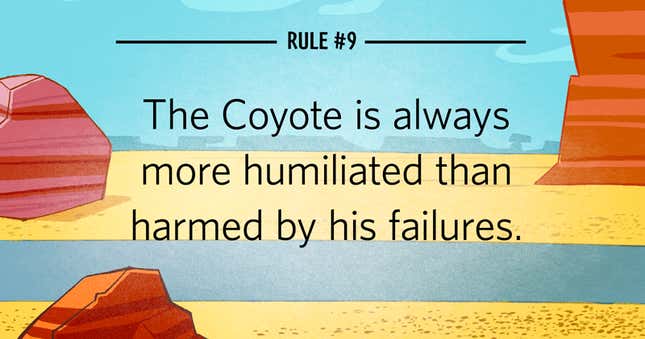
Think of the structure of a story—any story—as a long background setup. The individual scenes or passages may function as their own little stories, but they’re also punchlines; they upend/reply to/illuminate/are illuminated by/resonate with what came before. That dynamic heightens their power, and a comic story is no different from any other in this respect.
That dynamite gag from up top is a fine standalone surprise, but much of what actually makes it funny, as opposed to merely absurd, comes from its place in Fast and Furry-ous, how it relates to the preceding four minutes. You laugh bigger if you’ve taken in the whole story up to that point, from the beginning, because what you’re laughing at is bigger than this one silly gag: it’s the bigger picture this one silly gag suddenly has made clear.
That bigger picture reveals why Rule 9 is not just false, but cosmically, spectacularly false, even while most individual Wile E. Coyote and Road Runner gags make it seem like plain truth. So, let’s take in the whole story, from the beginning, and see what’s wrong with Rule 9.
The first joke of Fast and Furry-ous (which you should watch now) arrives a few seconds after the opening credits, and it seems to confirm Rule 9. The Road Runner is speeding along, the frame freezes him mid-stride, and you see: “ROAD RUNNER,” and then beneath it, between parentheses and in slightly smaller lettering, “ACCELERATII INCREDIBUS.” The setup here is simple, just the fraction of a beat that passes between the moment you recognize the format of a scientific name and the moment you discover your leg is being pulled. You’re not expected to guffaw, at this point, just to smile; you’re just being invited to loosen up and get into the spirit of things.
A version of this gag repeats moments later, introducing Wile E. Coyote, but with the silliness ratcheted up just a bit. The freeze-frame captures the coyote watching the Road Runner from a cliff-top, binoculars in hand, in the act of licking his chops immodestly, and identifies him as “COYOTE (CARNIVOROUS VULGARIS).” This time, the punch isn’t the mere fact of the scientific name being a gag—you were expecting that—but rather the put-down it contains. You read it, then you look back up at Wile E.—his skeletally thin body; his hungry, jaundiced, red-ringed eyes; that greedy, flushed, profane tongue; his grotesque, frozen leer—and recognize him as, yep, a vulgar doofus.
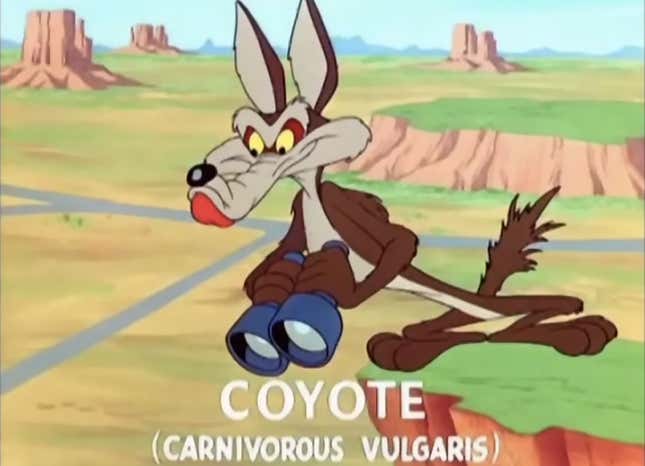
Now the coyote makes his first-ever on-screen attempt to catch the Road Runner. It’s pretty shabby! He just ties a napkin around his neck, grabs a fork and knife, and takes off running, leading to what is, for my money, one of the great tragicomic sights in all of filmmaking:
Note, if you please, that this pursuit doesn’t really backfire on Wile E. in the way we’ve come to think of as familiar. He doesn’t plunge over a cliff, or get flattened by a bus, or blow himself up with dynamite. He just fails, and is deflated by it. The joke, like the coyote’s attempt, is simple: the feebleness of this knife-and-fork plan, the silly sight of those flailing utensils, the Road Runner’s sudden burst into the distance, and this face, at which I will laugh forever:
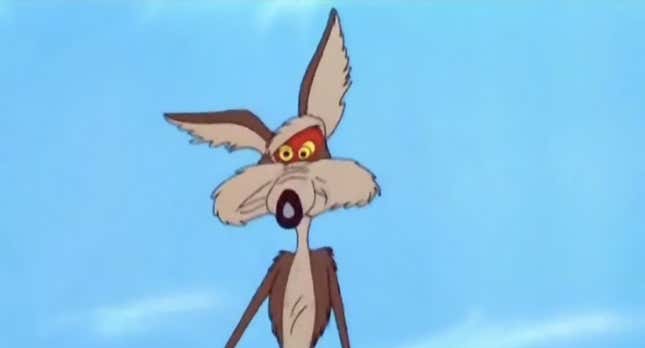
Wile E.’s next attempt is a bit more thought-out—at least it acknowledges that he has no chance of winning a foot chase—but still rather simple. He waits ahead of the Road Runner to ambush him with the lid of a buffet tray.
As a joke, this is more elaborate, too, misdirecting you with the Road Runner’s sudden stop and reversal of direction and the coyote’s angry decision to chase him. Wile E. and Road Runner were conceived, initially, as a lampoon of chase cartoons like Tom & Jerry, and this gag plays on the audience’s familiarity with those lesser cartoons’ repetitiveness (so much of Tom & Jerry is just them running back and forth, boringly, before something stupid happens for no interesting reason) without making the parody explicit. Just when Wile E. slams down the tray lid and another chase seems afoot, the punchline arrives, bringing the encounter to a sudden, abrupt end.
This would have landed harder in 1949 than now. In the 21st century, we’re all much more familiar with the rhythms and conventions of Wile E. Coyote and Road Runner cartoons than with those of Tom & Jerry, which is a nice way of saying nobody gives a fuck about Tom & Jerry anymore. Even without the parody element, though, it’s still a funny gag, turning on its visual framing: the Road Runner disappears from the screen, and you think he’s gone and expect Wile E. to have to chase him, and then suddenly he’s back in the frame—and then, just for a fraction of a second, you expect Wile E. to notice he’s about to crash into his own trap, but he’s such a goddamn boob he can’t even do that.
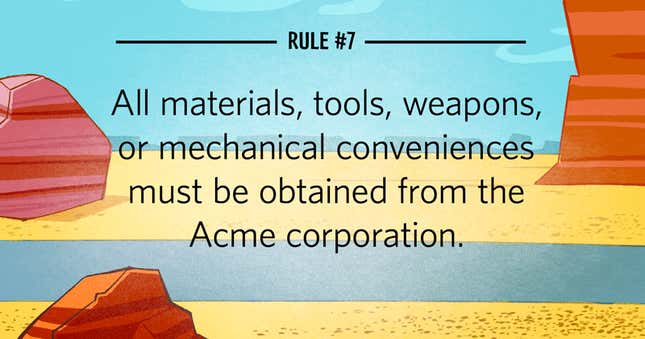
The third try begins with a box labeled “ONE GENUINE BOOMERANG: GUARANTEED TO RETURN,” and clearly not labeled “Acme Corporation.” None of Wile E.’s materials, tools, weapons, or mechanical contrivances bear any mark of the Acme Corporation in Fast and Furry-ous. Rule 7 is no rule at all.
The boomerang box doesn’t need Acme branding to be useful. It’s both narration and setup. Lingering on it for a moment gives you a chance to understand how this is supposed to work, which is helpful, because the boomerang itself is not some arbitrary choice. This is where Tom would have had a shotgun, because a shotgun is a logically sound, boringly obvious, unfunny hunting tool*, and Tom & Jerry cartoons are boringly obvious and unfunny. Wile E. Coyote has a boomerang, because he is the sort of hapless nincompoop who gets a boomerang when he could have gotten a shotgun, and because whatever the hell you were expecting him to deploy next in his pursuit of the Road Runner, it was not a boomerang.
*The exception, here, is when the shotgun is in the hands of Elmer Fudd. In Elmer’s case, the shotgun is part of his package as a hunter—after all, what makes a hunter a hunter, at bottom, is that he has a long gun for killing animals. Elmer Fudd has to fill out this template in an instantly recognizable way (woodsman-y clothes, big long gun) so that the subversion of the template (Bugs tying the barrels of the shotgun into a knot, or Elmer falling madly in love with what he doesn’t realize is the rabbit he’s come to kill) likewise will register quickly and easily enough to make you laugh.
This becomes a familiar feature of Wile E.’s schemes: his choice of hunting method reveals him and his mental state in funny, surprising ways, even before it fails. It’s character development—something Wile E.’s creators, unlike most animators of the time, actually cared about. You don’t know Tom nearly as well as you know Wile E. Coyote. Tom makes choices anybody would make; Wile E. Coyote makes choices that only Wile E. Coyote would make.
It’s also just smart comedic writing, taking advantage of every opportunity to find humor in the proceedings. If the gag is going to end with Wile E. falling 10,000 feet off a cliff, why get there via 18 seconds of generic, unfunny running when you could have it happen because Wile E. turned a refrigerator, a meat grinder, and an electric motor into a back-mounted snow machine in an obviously boneheaded attempt at chasing the Road Runner across the hot desert on skis?
This storytelling practice gave Wile E. Coyote and Road Runner cartoons a rhythm almost exactly the opposite of Tom & Jerry’s. The latter punctuates generic, repetitive chase sequences with over-the-top, often jarringly violent outcomes—Tom getting sliced into cross-sections, or having all the skin ripped off his tail, or whatever—and screaming in agony. Their theme is the variety of extreme, gross, painful punishments they visit upon Tom. By contrast, Wile E. Coyote cartoons lay out unique set pieces built around Wile E.’s often elaborately ambitious plans, and find humor in funneling them all to a pointedly small number of outcomes—falling off a cliff, or blowing himself up, or being flattened—none of which seem to hurt him all that much. The reason for that is very near to what Wile E. Coyote and Road Runner cartoons are about.
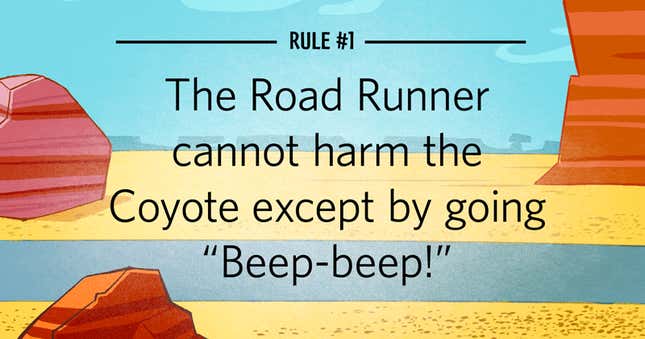
Back to the gag. Wile E. gives his boomerang a test throw, and immediately is whacked from behind by another boomerang—“ANOTHER GENUINE BOOMERANG, GUARANTEED TO RETURN,” reads its box—thrown by the Road Runner. For a moment this surprise seems like it’s the punchline. Wile E. bares his teeth and coils himself to give chase—again, in the then-familiar grammar of Tom & Jerry, this was how you knew one unfunny bit had ended and a boring stretch of narratively useless running was about to connect it crudely to the next one—but then, whap, Wile E.’s own boomerang returns to whack him in the back.
This pulls a neat little reversal (on which the cartoon wisely doesn’t linger) that changes the meaning of the Road Runner’s boomerang. Again, if this were Tom & Jerry, first of all, the second box would not have the absurd little “ANOTHER BOOMERANG” joke on it, but more importantly, the simple fact of Jerry having his own boomerang, and hitting Tom with it, would be presented as the punchline, as if that in any way constituted a funny joke on its own, because Tom & Jerry sucks and was made by morons to whom humor was an incomprehensible alien language. Here, that boomerang works in service to—it sets up—a moment of actual humor: a joke at Wile E. Coyote’s expense.
Think about it. Anybody could be whacked in the back by something somebody threw at them; that’s really no kind of defeat, and it isn’t funny either. What gets Wile E. in this gag isn’t the Road Runner’s boomerang. It’s the moment he loses his cool, reverts to his instinctive impulse to give chase, and forgets about his own boomerang. The first time you see this bit, you forget about Wile E.’s boomerang, too. You expect the stupid grammar of Tom & Jerry—more goddamn running—only to be surprised by a sudden resolution that implicates Wile E. in his own failure. The defeat isn’t that Wile E. got hit, or who hit him; it’s that he was made to look like an idiot.
Now, okay. This isn’t the funniest joke in the world. But! Like the Road Runner’s boomerang, it’s setup for bigger punchlines to come; it’s part of the structure the first few gags of Fast and Furry-ous have been building. There’s a reversal coming, an upending of carefully established expectations, not in the next bit but soon afterward, and it will land more solidly in part because of this one. Have you spotted it?
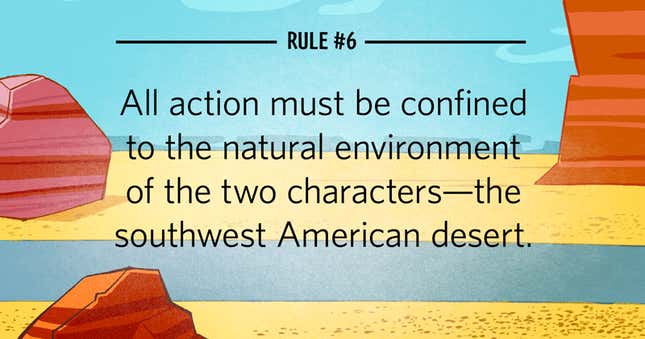
Wile E.’s fourth try provides a spectacularly unfair and mean-spirited chance to see it coming. He paints a fake crosswalk on the road and plants a “SLOW: SCHOOL CROSSING” sign in the middle of it. Then he traipses across it in schoolgirl costume ... and is blasted aside by the speeding Road Runner, who returns to hold up a sign of his own, reading “ROAD RUNNERS CAN’T READ.”
There’s abundant funny stuff here. The image of Wile E. in his costume is funny. The Road Runner’s sign is funny because it makes you recognize that you’d adopted Wile E.’s insane line of thinking: Oh, right, duh, of course roadrunners can’t read. What kind of dunce expects a friggin’ bird to slow for a crosswalk? But, wait just a goddamn minute: this Road Runner clearly can read! He could read well enough to get a boomerang, not to mention the sign saying he can’t read! This is bullshit! Fuck that Road Runner!
Wile E. agrees with you. Look at the face he makes after he sees the Road Runner’s sign. I’d watched Fast and Furry-ous like 200 times in my life before I ever noticed this face (I was always distracted by the sign), and it is wonderful.
Here I must note two things. The first thing is that a freeze-frame of Wile E.’s face does not do this expression justice; like an actual living person’s expressions, it is dynamic and has to be seen in motion to be appreciated fully. The second thing I must note is that Wile E. Coyote is one of the finest comedic performers of all time.
Yes, yes, I know, he’s not a real performer, just a drawing, and never really “existed” in the way, say, Lucille Ball did. Did you ever watch Lucille Ball act in person? Was her physical existence ever that important to your experience of watching her be funny? Not for me. As far as any ordinary viewer’s actual lived experience goes, they’re both images on screens, and both make me laugh my goddamn head off. If there’s no actual acting coyote to whom the credit should go, fine. Let’s take a moment to fawn over his creators, then.

In their heyday, Jones’s Warner Bros. team worked miracles coaxing never-before-animated depths and shades of personality from hand-drawn faces. The most obvious example is Bugs Bunny, of course.
The Jones gang did their most important work with Bugs years after he’d already become Warner Bros.’ biggest animated star. Bugs was a rabbit of action in his early years, an active prankster; he’d get his antagonist looking one way, and then boot him in the ass, or plant a big kiss on him. He distinguished himself from Warner Bros.’ other mischievous woodland anarchist, Daffy Duck—back then more of a manic, hyperactive screwball showman than the vain, aggrieved, pompous rival he came to be later—by the attitude of sly, winking detachment with which he defeated his enemies, but he defeated them actively, by the things he did to them, and usually with a giant, wide-eyed, shit-eating ain’t-I-a-stinker smile on his face.
That big smile worked! It created ironic distance between his expression and his actions; he was like a curdled, wised-up rejoinder to the wholesome, well-intentioned Mickey Mouse. And anyway, those earlier Bugs Bunny cartoons were fast-paced and action-centered; they didn’t need a Bugs whose facial expressions alone could communicate all the elements of a joke.
When Jones’s crew got ahold of Bugs, though, something wonderful happened. They ditched the default smile; relaxed and loosened his eyelids, brows, pupils, and mouth; and found they could inject Bugs’s cool, ironic, mocking personality into a crazily diverse array of expressions. Suddenly, he could be just as much an anarchic force as he’d ever been, even while standing still. Get a load of this astonishing sequence from 1952’s rightly legendary Rabbit Seasoning ...
Video via YouTube
... in which a discernible through-line of mocking, fourth-wall-breaking playfulness connects and makes a joke of every one of Bugs’s lines, even as he cycles through a handful of disparate affects, and in which he accomplishes as much comic mayhem as ever, but with a bare minimum of actual participation.
This is Bugs taken to his logical extreme, so much smarter and more confident than the idiots around him that he just gives them gentle nudges and lets them humiliate themselves. His primary engagement is with the audience. He’s never, not even for a second, not making fun of Daffy Duck, to the audience, even when he appears to be talking sincerely to Elmer Fudd. Not only is he doing this with his face and voice alone, he’s doing it with a relaxed confidence and subtlety of expression that make Groucho Marx look like a sweating, flailing vaudevillian ham.
Watch Bugs’s face at the moment when Daffy discovers their “pronoun trouble.”
The slack brow and sleepy eyelids. The patient blinking. That sly glance at the audience, which lasts only as long as Daffy, too, is talking to the audience. In three seconds this nincompoop is going to get himself shot in the face without my help at all.
Bugs Bunny says exactly that very precise thing, to you, with his animated rabbit face, as clearly as Dick Halloran using psychic powers to ask Danny Torrance if he’d like some ice cream. Bugs’s face, which barely moves at all in this interaction—which is all but completely inert beside and relative to Daffy’s wild gesticulations—delivers a comic monologue you could overlook entirely while still rightly finding Rabbit Seasoning screamingly funny. That’s amazing!
Do not be distracted by the humble reputation of cartoons. This portion of Rabbit Seasoning, like so much of the work Chuck Jones and his gang did on Bugs Bunny and Daffy Duck, is incredibly accomplished filmmaking. It is easier than what these same people pulled off with Wile E. Coyote.
Unlike Bugs, Daffy, and virtually all other Warner Bros. characters, Wile E. Coyote—at least in his earliest, best incarnations, before his series was handed off to hacks and went to shit—does not get dialogue to help express himself. He does not even get a voice. On top of that, he doesn’t even get to share the screen with a dynamic, lively counterpart like Daffy Duck against whom he can define himself. In all the barren desert where he pursues the blank, inexpressive Road Runner, his own face and body are the only things capable of recognizable emotional expression.
The music and camera work do their part to convey dramatic tension, but whatever sense the audience will get that the proceedings have actual stakes, that these explosions and plunges and crashes aren’t just empty noises but have actual consequences worth paying attention to and laughing at—whatever tension the joke setups will create for their punchlines to burst—must be communicated by Wile E. Coyote, with his face and his body language. That’s quite a burden to heap on this skinny wretch, which is to say that it’s a remarkable rule for his creators to have imposed upon themselves.
Rule 4 brought out some of the Jones crew’s finest work. In the dozen brilliant cartoons prior to the series’ terminal decline, infinite subtle variations of frustration, excitement, desperation, greed, fear, humiliation, hunger, overconfidence, triumph, shock, and despair pass across that haggard face, all of them of a piece with each other, recognizably inflected by Wile E.’s essential haplessness. Virtually any two-second clip of Wile E.’s face presents something carefully and lovingly made, to laugh at, or to set up the next laugh, or both.
Even—as in the case of that tired, fed-up side-eye beneath the “SLOW: SCHOOL CROSSING” sign—when there’s enough happening on the screen for you to miss it altogether, Wile E.’s face is doing the work. The rules required it.
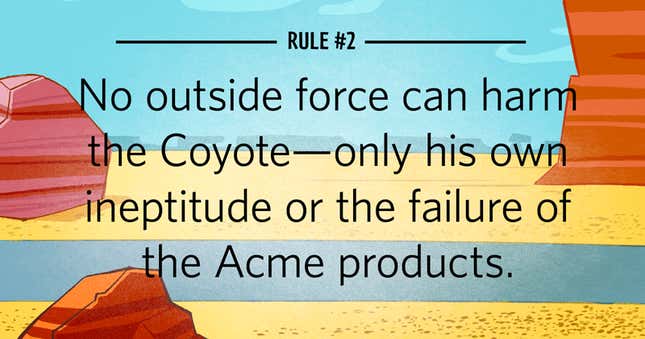
The meta-structure I’ve been mentioning—the big background joke that the individual bits of Fast and Furry-ous are setting up—is about to deliver its first punchline. The four preceding setpieces have established a pattern and a sense of a theme. This next one completely undermines all of it.
Here’s what you see, first:
First of all, this is fucking hilarious. Wile E. Coyote’s schemes, up to this point, have been increasing in cleverness with no evident gain for him. Now he has abandoned cleverness altogether and just strapped his narrow ass to a damn rocket (with a dumb pair of brown trouser belts, no less). The sheer sight of it, before he even lights the fuse, is hilarious. You know exactly where his head’s at: Read THIS, you turbocharged motherfuckin’ pigeon!
Still, on what what we’ve been positioned to understand as the terms of the conflict—Wile E. Coyote trying to capture and eat the Road Runner—this plan definitionally cannot succeed. The thing to which he has strapped himself has no steering or stopping mechanism whatsoever. It is a giant explosive device, built to fly straight, and pointed at a quarry we’ve just now seen changing direction side-to-side across a huge rock edifice. That dummy! Even if he miraculously intercepts the Road Runner, he’s just gonna blast them both to pieces! A universe in which this rocket can kill the Road Runner is, by definition, also a universe in which it will vaporize the coyote strapped to it when it does.
The rocket’s fuse burns long enough for a grownup viewer to have this thought, and I don’t think that’s an accident. And then that smile spreads across Wile E.’s face, and grows, and grows, until it has become a mad, bloodthirsty grin, and you understand: this is not a device for capturing food. It is a device for blasting away the entire goddamn side of that butte and sending the Road Runner to hell, whatever the consequences. Wile E. Coyote doesn’t care about getting blown up.
Wile E. Coyote is not merely trying to eat the Road Runner anymore. We’re well beyond that now. He’s after something else. He’s a goddamn madman!
For an American audience in 1949, this moment would have resonated—consciously or not, and whether or not Jones and Maltese deliberately angled it this way—with the horrors of the global war that ended only four years before, and especially the mad, absolute, self-destructive zeal with which the Axis powers fought at their worst and most desperate. In that small moment, before the rocket launches, Wile E. remains a villain Americans recognize, and the Road Runner remains the plucky protagonist, minding his own business until unprovoked hostility forces him to defeat the bad guy.
Spare a moment to appreciate the comic discernment and timing shown by Jones and Maltese (the writer), here. They held off Wile E. Coyote’s turn to explicitly lethal weaponry until the choice would reveal something about the character, and then skipped right past intermediate, rational options—a bow and arrow, an ax, a gun—to an extreme one with vast suggestive power, the mere sight of which is good for a laugh. This is good joke-telling!
It’s also thematically important. The American generation buying movie tickets in 1949 had just lived through, served in, and won World War II. The popular narrative of the war, then and (mostly) now, had their young, isolationist nation entering the fight against its will, given no choice by the unprovoked aggression of fanatical villains, then rallying to save the world. Not surprisingly, this triumphal theme was everywhere in the popular mass entertainment of the day. No movie audience ever has been more primed to expect to see—and identify with—a plucky underdog triumphing over an arrogant aggressor coming after them for no good reason.
So far, Fast and Furry-ous has given the audience just enough proactive participation from the Road Runner to engage that familiar template. He sprinted away just when Wile E. was gaining on him; he held the tray lid up for Wile E. to crash into; he distracted Wile E. with a boomerang; he straight-up knocked him over in the crosswalk. He acted. If you were expecting him to be the plucky protagonist, you could still see him that way, up to this point.
And then the fuse burns down, and the rocket launches, and ... wait, what?
Even just as a standalone joke, divorced from the rest of Fast and Furry-ous and the broader historical context, this cracks me the fuck up. It’s a perfect trio of tragicomic visuals. There’s the rocket’s instantly, hilariously wrong launch trajectory; the way the camera lingers for a beat on the empty launch pad; and then—when you’ve had time to maybe picture Wile E. blasting over the horizon on his wayward rocket—the reveal of the poor fucker embedded in the rocky outcropping not 10 feet above where he grinned that devilish grin. Mechanically, just as a visual gag, it’s wonderful. Thematically, it’s something more than that.
The Road Runner did not thwart this scheme; he was not clever or plucky; he did not even say “Beep-beep!” to startle Wile E. or for any other reason. He was a cloud of dust in the distance. He did not influence the action; he did not outwit or outrun or in any other way defeat the bad guy; the action never threatened him. He was not a participant at all, and certainly not the hero. More to the point: was he ever?
With this bit, Jones and Maltese are goosing their triumphal, self-satisfied 1949 audience, hard. Turn around and look behind you: the Road Runner has been a passive participant, very nearly a bystander, all along. All he did in the first set piece was run away. All he did in the second was stop running, then passively hold up Wile E.’s tray lid. In the third, he threw a boomerang, but didn’t really accomplish anything; what stopped Wile E., and what humiliated him, was his own boomerang coming back. In the fourth, all the Road Runner did was not stop, not react or respond—he was inert, literally: an object in motion that merely continued moving. In this one, he merely existed as an object the main character pursued. He might just as well have been a cheeseburger, or a briefcase full of money, or a rug that really tied the room together.
That’s right: the Road Runner is a MacGuffin! He facilitates drama by motivating one party into conflict with another, but is himself narratively inert. The drama arises between his pursuer, Wile E., and the forces that oppose his efforts to obtain the MacGuffin. But, if Wile E. Coyote is a character, and the Road Runner is the MacGuffin, what is the opposing force? What is the conflict?
Chuck Jones figures that the conflict is between Wile E. and “his own ineptitude or the failure of the Acme products,” and that’s a reasonable conclusion, at this point. You’re a reasonable person, and so you say the rocket sure looked like one hell of a product failure, and ineptitude works as an explanation both for Wile E.’s decision to strap himself to it in the first place, and for the dumb-ass schemes prior to that. Ha ha, that dopey coyote, what a doofus, he can’t get anything right.
Okay, fine. Explain what happens next, then.
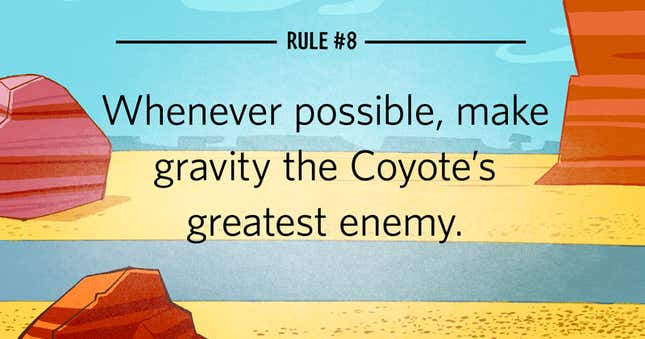
Wile E. has done his homework this time. He has drawn schematics and used physics; he has used a pendulum to determine precisely where his boulder will land. Back at the beginning of Fast and Furry-ous, he spied on the Road Runner with regular binoculars, but now he has upgraded to a tripod-mounted telescope. Jones makes a point of showing us its sophisticated targeting reticle.
Just as the rocket’s fuse burned long enough for you to recognize its absurdity, the series of shots showing the elements of this latest Wile E. scheme is, both in content and in the calm patience with which it is delivered, setting you up. This is commentary on what came before; the adjustment toward a precise, scientific approach affirms your sense that Wile E.’s previous schemes were foiled by their clumsiness and stupidity. Now he is being smart. This is not a mail-order boomerang! This is progress!
The thing is, even if you’re watching this in 1949, with no idea of what happens in Wile E. Coyote cartoons, you know this is not going to end with a happy, satiated coyote gnawing contentedly on the bones of the Road Runner. The elegant rationality of the scheme seems to imply that a truly spectacular display of ineptitude will be required to prevent its success. This is the tension, the expectant state this joke—and the whole cartoon up to now—have carefully set up: Oh boy, how’s he gonna fuck it up this time?
He’s not.
He did everything right. Everything. He timed it perfectly. The Road Runner sped into the ravine; Wile E. yanked away the keystone; and the boulder tipped over the edge, exactly as it was positioned to do, exactly as gravity dictated it must. Wile E. made this face:
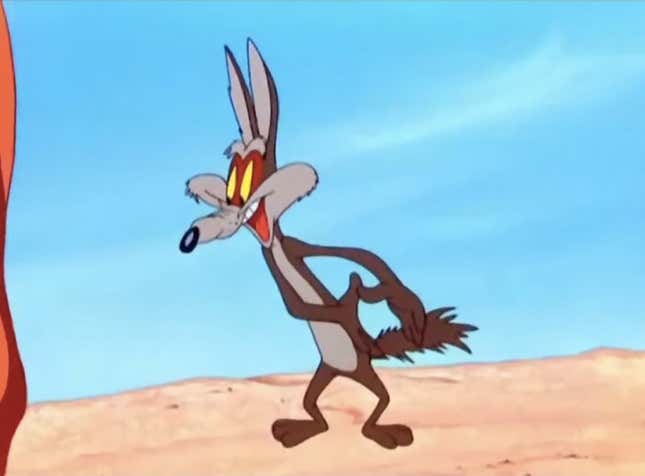
This poor, desperate fucker. This hopeless sad sack. Look at him. That is the face a little kid makes on Christmas morning: perfect, innocent, radiant joy. It’s the face that goes with the sudden rewarding of the most outrageous faith—with perceiving a fair and discernible order to the world, and deriving from that a sense of compatibility with it, a reassurance that fulfillment is possible within it. Wile E. Coyote has hope! He believes, man.
And then: physics breaks! According to all the familiar and heretofore observable properties of the universe, Wile E. Coyote was about to crush the Road Runner with a giant friggin’ boulder. Then gravity itself leapt into the breach, like a soldier throwing himself onto a grenade lobbed at his friends. Just what in the damn hell is going on here?
With each set piece, Fast and Furry-ous has invoked a notion of what you’re watching—an idea of what this is, and what it’s about, and why—and then destroyed it. It started small, defying the rhythm of the chase cartoons that preceded it. Next, with the rocket, it blew a raspberry at the more basic structure of those cartoons: This is not a contest between Wile E. Coyote and the Road Runner at all. Now it’s pulling back farther, to show you that this isn’t a comic study of a hapless, self-defeating boob, either. The forces at work against him clearly go far beyond his own internal inadequacy.
This is to say that so far, every system of understanding either the audience or Wile E. has tried to deploy has been revealed as a joke. If you’re starting to think that the heart of this is about the folly of the search for discernible order in the chaotic universe or some bleak thing ... well, keep watching. The very next gag has something to say about that.
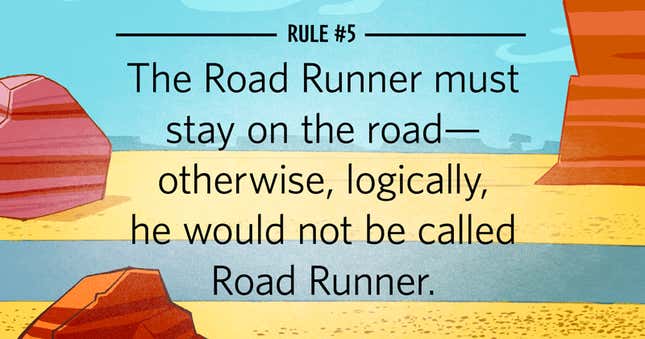
Wile E. Coyote believes in Rule 5, which should be the first reason to doubt it. His faith in the inviolability of Rule 5 is the basis of his next scheme, which begins with the sight of him once again painting white lines on the road, as he did for his failed crosswalk. This time, though, he’s diverting the road’s white center-line, leading it off into the desert and directly into a rock wall he then paints to look like a tunnel.
The thinking is something like: “Road Runner,” eh? I’ve got a road for you to run on, you jumped-up fuckin’ pheasant. I find I’m laughing not strictly at the sight of the painted-on tunnel, but at the mental image of what this scheme is meant to produce: the Road Runner pancaked against that rock face, and maybe Wile E. Coyote scraping him off with a spatula. Somehow this plan evokes Wile E. Coyote’s mind in a way that strikes me as generous and welcoming, Jones and Maltese inviting us to try out a language they’ve been teaching us. Once again, without dialogue, you know exactly where this character’s head is at.
And then this happens:
Here is the thing about Rule 5. It doesn’t mean what Wile E. Coyote thinks it means. It doesn’t restrict the Road Runner; it restricts the physical universe. The Road Runner follows the white line. The physical universe makes sure the white line follows Rule 5.
Well, okay, that is a thing about Rule 5. Here is the other thing about Rule 5:
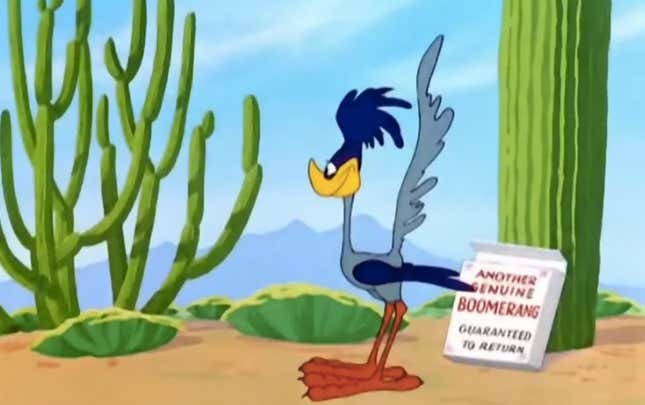
It’s pretty flexible when it needs to be.
At this point, the temptation is to break out the black turtleneck and go Ah-ha! So it is a bleak joke about swirling absurdity and disorder! If all the rules, including Chuck Jones’s, can be broken, then there are no rules! If every pattern is false, just a setup for the next punchline, then there are no patterns! It’s all anarchy, dammit!
Here’s some more to buttress this argument. Wile E. immediately forms a new empirical conclusion—This tunnel can be run through!—and is rewarded thusly:
That’s it, right? That’s the big teens-smoking-reefer-and-talking-big-ideas revelation, isn’t it? Chaos reigns.
Well, hang on. This fake-tunnel bit isn’t over yet. Just like the last time Wile E. busted out the paint brush to lay a trap on the road, the quarry who blasted right through that trap returns with an explanation:
It’s not text on a handheld sign this time, but it’s no less clear. There is a pattern here. Road Runner passes through; Wile E. crashes; Road Runner passes through. Structurally, there is a system: Road Runner may pass; Wile E. may not. This isn’t anarchy, but order. You just haven’t discerned its rules yet.
If your impulse is to articulate the nature of this order as Wile E. Coyote cannot succeed or Wile E. Coyote may not catch the Road Runner, you’re nearly there. You’re as close as Chuck Jones’s rules get. The remaining distance seems tiny—the difference between Wile E. Coyote cannot succeed and the truth seems slight and nearly meaningless—but it isn’t. It is, if anything, almost too big to take in.
You cross it with a question: Why doesn’t he just stop trying?
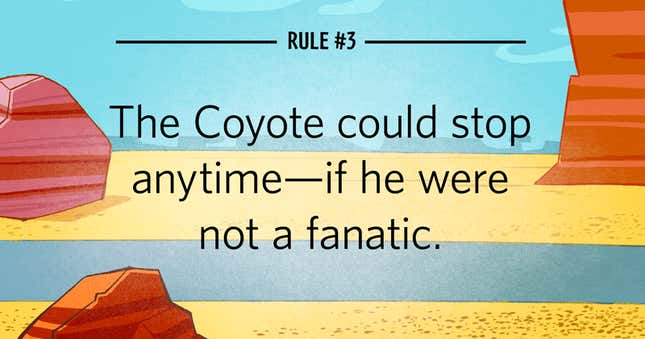
Wile E. Coyote will not catch the Road Runner. Pretty much every single thing that has had an opportunity to thwart him, from his own athletic limitations to the behavior of the natural laws around him, has taken it. Reality itself will change to ensure the Road Runner remains outside his grasp. Even the coyote, at a certain point (we can argue about when it is), clearly is aware of it.
And yet, here we are, arriving at the dynamite scheme from back up at the top. Here it is again; look for the mad gleam in Wile E.’s eye just before he pushes down:
That looks like fanaticism, doesn’t it? Perhaps Fast and Furry-ous—perhaps the entire Wile E. Coyote and Road Runner oeuvre—is about fanaticism. The one thing Wile E. can control, in this cruel universe where the underlying nature of reality will undo itself to let the Road Runner pass unimpeded through solid rock, is whether he will continue to subject himself to this shit, right? Maybe the joke is his pointless, stubborn persistence? Maybe, like Sisyphus, he’s his own tormentor? Couldn’t he just let the Road Runner go? Why doesn’t he stop?
The answer to that last one has been staring you in the face since that first sight of Wile E. Coyote perched on the cliff, eyeing the Road Runner through binoculars. It’s in his scientific name, in his waistline, in the background of every scene.
Consider:
Consider:
Ask: What the fuck else is he gonna eat?
Chuck Jones is wrong. Wile E. Coyote can’t stop anytime; he can’t ever stop. Yosemite Sam can stop. Elmer Fudd can stop. Daffy Duck can stop. They are fanatics. Wile E. Coyote is not a fanatic. Wile E. Coyote is starving.
There is no other food! If Wile E. will satisfy his desperate hunger, he must eat; to eat, he must catch the Road Runner; and he cannot catch the Road Runner. Just as the very armature of the world—biology, ecology, physics, logic, his own goddamn personality, everything—will warp and bend to ensure the failure of his next scheme, that same armature was bent from the very beginning to ensure that there will always, always be a next one.
The game was rigged from the start. Quitting it is just as impossible as winning. The stark, absolute order of Wile E. Coyote’s universe doesn’t have to do with preserving the Road Runner’s safety or punishing Wile E.’s effort, but actively and forcibly producing his humiliation. Not Wile E. Coyote cannot succeed, but Wile E. Coyote must fail.

Startled recognition. When this famished wretch is humiliated, endlessly, by his doomed pursuit of what he can neither have nor reject, what are you laughing at? What are you startled to recognize?
Here is a parable. For decades, a master artisan crafts works of beauty and genius. His creations are acclaimed by virtually all who behold them. Nearing the end of his life, the artisan, wealthy and revered, his name rightly and indelibly etched into the history of his medium, sets out to describe for posterity how he created such great works, the discipline underlying their brilliance. He writes down the rules he set for himself. And they are wrong. They completely miss the point of his own work. His system of understanding fails to encapsulate a reality he himself created. By the time anybody points it out, he’s been dead for years.
The game is rigged. It was rigged from the start. You, yourself, are part of the rigging; your nature produces your failure, and your failure produces the conditions that prompt your next doomed try. What are you trying to do? At what are you failing?
You are trying, like Wile E. Coyote, like Chuck Jones, like me, to make some sense of the world. You are forming a notion; an idea of the rules. That notion only ever can be incomplete; your mind is a baffling supercomputer nevertheless hopelessly inadequate to the task of understanding the full terrible complexity of the world around you. That notion will be blown apart (or dropped off a ledge, or run over by a bus), and you will recognize that it has been, that it was fatally incomplete to begin with—and that recognition will be the first tenet of the new notion, the seed of the next failure. On and on you will go, making sense of the world, forming notions of order, and being surprised in ways large and small by their failure, forever.
Can you stop? My friend, trying to stop forming notions of order is forming another notion of order. Forming notions of order is what you are: Intellectus inadaequtus. There is no escaping. Your mind is the setup; reality is the punchline; your life is the joke. And like all others, it has rules. It isn’t chaos. It is order. It is the order.
What can you do? All anybody can do; the same thing you’ve always done; what you did when Wile E. Coyote pushed down on that detonator and blew himself up. You can laugh at it. It’s pretty funny.
Illustrations by Jim Cooke
Contact the author at [email protected] or on Twitter @albertburneko.